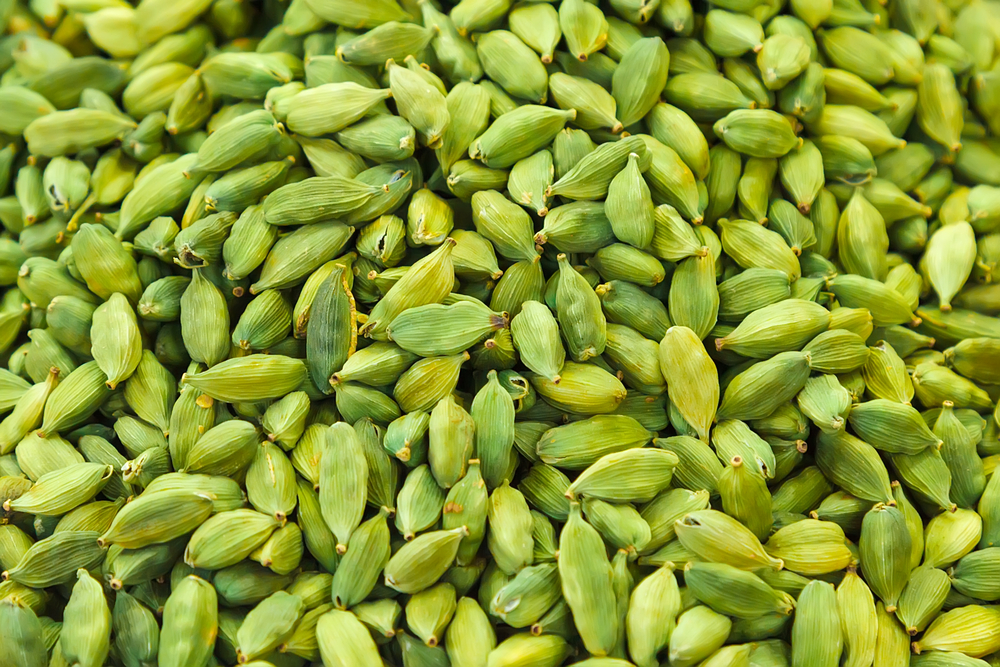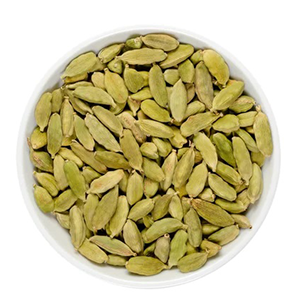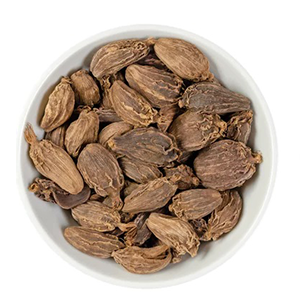
Cardamom, the aromatic jewel from the lush hills of Kashmir, adds an unparalleled charm to the region’s exquisite cuisine. Nestled in the northernmost region of India, the paradise-like land of Kashmir has always enchanted travelers with its breathtaking beauty and rich cultural heritage.
Kashmir, often referred to as “Paradise on Earth,” is not just known for its breathtaking landscapes and rich cultural heritage, but also for its distinctive and aromatic cuisine.
One of the key ingredients that has played a pivotal role in shaping the essence of Kashmiri cooking is cardamom (Elaichi). This flavorful spice, with its multifaceted benefits and unique flavor profile, holds a special place in Kashmiri culinary traditions.
In this article, we delve into the significance of cardamom in Kashmiri cooking, exploring its historical roots, health benefits, and its role as a culinary gem.
Historical Roots of Cardamom in Kashmir
Cardamom, scientifically known as Elettaria cardamomum, has a long-standing history in the culinary world, with its origins dating back to ancient times. In the context of Kashmir, this spice found its way into the region’s cooking through the historic spice trade routes. The aromatic hills of the Kashmir Valley offered an ideal climate for cultivating cardamom, leading to its integration into local cuisines. Over time, cardamom became an integral part of the rich culinary tapestry of Kashmir.
Aromatic Excellence: Flavor Profile of Cardamom
The allure of cardamom lies in its unparalleled flavor profile. Its distinct aroma is a blend of citrusy, slightly minty, and herbal notes, with a touch of warmth and sweetness. This complexity makes cardamom a versatile ingredient that can elevate both sweet and savory dishes. In Kashmiri cooking, cardamom often takes center stage in various dishes, imparting a unique and captivating flavor that resonates with the region’s cultural identity.

Cardamom’s Role in Kashmiri Cuisine
1. Kehwa: The Enchanting Elixir
Kashmiri cuisine is incomplete without the mention of the aromatic kehwa – a traditional saffron-infused tea. Cardamom plays a crucial role in enhancing the flavor of this beloved beverage. Its warmth and fragrant undertones complement the earthiness of saffron and the soothing properties of green tea, resulting in a beverage that warms the heart and uplifts the soul. Kehwa is not just a tea; it’s a symbol of hospitality and a gesture of welcome, deeply rooted in the Kashmiri culture.
2. Wazwan: A Royal Feast
The grandeur of Kashmiri cuisine is magnificently showcased through the wazwan – a lavish multi-course meal that exemplifies the art of cooking in the region. Cardamom, with its enchanting aroma, features prominently in many wazwan dishes. From the aromatic yakhni (a yogurt-based curry) to the rich and spicy rogan josh (a slow-cooked lamb dish), cardamom’s subtle touch elevates the taste profile of each dish, creating a symphony of flavors that lingers on the palate.
3. Rice Delights: Pulao and Biryani
Rice, a staple in Kashmiri cuisine, finds its elegant partner in cardamom. The fragrant and subtly sweet flavors of cardamom enhance the richness of traditional pulao and biryani. The spice is often used to infuse the rice with its essence, giving the dishes a delicate yet captivating aroma that transforms a simple meal into a gastronomic experience.
Use of Cardamom in Sweets and Desserts
The significance of cardamom extends to the realm of sweets, where it continues to dazzle with its aromatic charm. Kashmiri desserts are known for their luxurious textures and unique flavor profiles, and cardamom plays an essential role in creating this indulgence.
1. Shufta: A Confectionery Extravaganza
Shufta, a traditional Kashmiri dessert, is a medley of dried fruits, nuts, and saffron, sweetened with honey or sugar. Cardamom’s sweet and spicy undertones enhance the flavors of the various components, harmonizing the diverse elements into a delectable symphony of taste and texture. Shufta’s preparation often involves a touch of cardamom, which lends its enchanting fragrance to the dessert.
2. Phirni: Creamy Indulgence
Phirni, a creamy rice pudding delicacy, holds a special place in Kashmiri celebrations. Cardamom’s floral notes complement the velvety texture of the phirni, creating a dessert that is as visually appealing as it is tantalizing to the taste buds. This classic dessert is a testament to how cardamom weaves its magic even in the most delicate and intricate of sweets.
Type of cardamom used in Kashmiri cooking
Cardamom, known as “elaichi” in Hindi, is a crucial ingredient in Kashmiri cooking. The region’s culinary traditions are enriched by the use of two primary types of cardamom: Green Cardamom (Elettaria cardamomum) and Black Cardamom (Amomum subulatum). Each variety brings its own unique flavor, aroma, and characteristics to the intricate tapestry of Kashmiri cuisine.
1. Green Cardamom (Elettaria cardamomum)

Flavor Profile: Green cardamom, often referred to as “true cardamom,” is recognized for its delicate and aromatic flavor. It features notes of citrus, mint, and herbal undertones, with a touch of sweetness.
Appearance: The pods of green cardamom are small and vibrant green in color. They are known for their slender shape and distinct triangular cross-section.
Use in Kashmiri Cooking: Green cardamom is a staple in Kashmiri cuisine, finding its way into both savory and sweet dishes. Its enchanting aroma and nuanced flavor make it an essential ingredient in the famed “Wazwan” feast, where it is used to enhance dishes like Rogan Josh, Yakhni, and Pulao. Additionally, it infuses desserts like phirni and shufta with its unique character, adding depth to the sweetness.
2. Black Cardamom (Amomum subulatum)

Flavor Profile: Black cardamom, also known as “Badi elaichi” or “Kali elaichi” in Hindi, boasts a distinct smoky and earthy flavor profile with hints of resin and camphor.
Appearance: The pods of black cardamom are larger and dark brown to black in color. They have a rugged appearance and are known for their irregular shape.
Use in Kashmiri Cooking: Black cardamom holds a significant place in Kashmiri cuisine, particularly in dishes that embody the region’s rustic flavors. It is often used in savory dishes like meat-based curries and gravies, contributing a deep and robust essence. In the traditional Rogan Josh, black cardamom complements the meat’s richness, adding a smoky undertone that enhances the overall taste.
Health Benefits of Cardamom
Beyond its culinary prowess, cardamom offers a range of health benefits that have been recognized for centuries. Rich in essential oils, antioxidants, and vitamins, cardamom boasts a variety of advantages:
- Digestive Aid: Cardamom is known to soothe digestive discomfort and promote healthy digestion. It can alleviate issues like bloating, gas, and indigestion, making it a favored spice after indulgent meals.
- Anti-inflammatory Properties: The antioxidants present in cardamom contribute to its anti-inflammatory properties, which can aid in reducing inflammation and improving overall health.
- Respiratory Health: Cardamom’s aroma contains natural compounds that can help clear congested airways and promote respiratory health. This makes it a popular choice for natural remedies aimed at relieving coughs and colds.
- Heart Health: Studies suggest that cardamom may contribute to heart health by helping to lower blood pressure and cholesterol levels.
Preserving Tradition and Fostering Connection
Kashmiri cooking, like any culinary tradition, is not just about the ingredients and techniques; it’s about the stories and connections it nurtures. Cardamom, deeply rooted in Kashmir’s history, culture, and cuisine, is a thread that weaves together generations through shared meals and cherished memories. Whether it’s a family gathering, a festive celebration, or a simple meal, cardamom-laced dishes serve as a reminder of the past while fostering a sense of togetherness and continuity.
People also ask:
-
How is cardamom used in Kashmiri rice dishes?
Cardamom is often added to rice dishes like “Zafrani Pulao” (saffron rice) to infuse the rice with its fragrant aroma. It complements the saffron’s flavor and adds depth to the dish.
-
What is the significance of cardamom in Kehwa?
Cardamom is a key ingredient in Kashmiri Kehwa, a traditional green tea infused with spices. It contributes to the tea’s aromatic and slightly floral taste, making it a popular welcome drink for guests.
-
How is cardamom used in savory dishes?
Cardamom is used in marinades for meats and poultry, adding depth to dishes like “Rista” and “Gushtaba.” It can be used whole or ground to infuse the dishes with its unique flavor.
-
Can I use whole cardamom pods in cooking?
Yes, whole cardamom pods are commonly used in Kashmiri cooking. They can be added to dishes to infuse the flavors subtly. You can also crush the pods to release the seeds and flavor.
-
Is cardamom versatile in Kashmiri cuisine?
Yes. Cardamom is versatile in Kashmiri cuisine, being used in a wide range of dishes, from savory gravies to sweet desserts and even yogurt-based preparations.
-
What precautions should I take when using cardamom in Kashmiri dishes?
When using cardamom, remember that a little goes a long way. Start with a small amount and adjust according to taste. It’s also a good idea to use fresh cardamom for the best flavor.
-
Can I experiment with cardamom in my own cooking?
Yes! Cardamom’s unique flavor can be a delightful addition to many dishes beyond Kashmiri cuisine. Feel free to experiment and explore how it can enhance your own culinary creations.
Final Words on Cardamom in Kashmiri Cooking
Kashmiri cooking’s reliance on green and black cardamom showcases the culinary prowess of the region. These two distinct varieties contribute to the depth and character of the cuisine, creating a symphony of flavors that resonate with the cultural identity of Kashmir. As one savors the enchanting aroma and taste of cardamom-laden dishes, they also partake in a journey through history, tradition, and the rich tapestry of Kashmiri gastronomy.
